全文HTML
--> --> -->为实现对盐度的高精度遥感探测, 本文提出了融合水体布里渊(Brillouin)散射与Raman散射光谱的盐度精细反演方法. Brillouin散射是指入射到介质的光波场与介质内的弹性声波场发生相互作用而产生的一种光散射现象. Brillouin频移量的大小与介质内的声速相关, 而声速变化是由温度和盐度的变化引起的, 因此Brillouin频移量也受温度和盐度的影响[10]. Raman散射光谱强度受温度和盐度变化的影响, 散射光谱低频部分与高频部分的面积比值与温度和盐度变化具有定量的函数关系. 由于激光雷达遥感探测方法可以同时探测Raman光谱和Brillouin频移这两个参量, 融合Raman散射光谱和Brillouin频移与盐度和温度之间的关系, 建立海水盐度的高精度反演模型. 该模型的建立使得盐度反演不需要参数假设, 提高了盐度反演精度, 为研究海洋学的发展提供更可靠的数据支持.
2.1.Raman散射理论
Raman散射是由分子振动或固体中晶格振动引起的光散射现象. 在整个的4π立体角范围对各方向的平均的单个分子n←m振动跃迁的总散射截面σmn是[11]:在90°散射方向上进行Raman测量, 此时激发光偏振方向垂直于散射平面, 微分Raman散射截面公式如下[12]:
根据(2)式和(3)式可以看出, Raman散射截面是一个与温度、激发频率和溶液浓度(与盐度相关)等相关的函数.
2
2.2.Brillouin散射理论
Brillouin散射是指入射到介质的光波场与介质内的弹性声波场发生相互作用而产生的一种光散射现象. 散射光的频率相对于入射光的频率发生了变化, 而且这种变化和散射角以及散射介质内的声波场的特性有关. 海水Brillouin频移表示为[13-16]海水折射率n与声速V均与海水温度和盐度相关, 因此在已知入射波长时, 海水Brillouin频移是与海水温度和盐度相关的二元函数. 目前利用Brillouin散射探测海水参量, 主要是用于探测海水温度. 根据Brillouin频移随温度和盐度变化的规律, 利用最小二乘原理, 获得海水温度反演公式如下[17-21]:
 图 1 海洋温盐探测高光谱激光雷达分光系统光路原理图
图 1 海洋温盐探测高光谱激光雷达分光系统光路原理图Figure1. Experimental setup for filter system of ocean temperature and salinity detection high-spectral-resolution-lidar.
4.1.基于Raman散射的水体温盐反演
Raman散射光谱法探测海水温度或盐度, 是利用探测到的散射光谱建立与海水温度或盐度之间的函数关系. Haltrin和Kattawar[22]将常温下纯水的伸缩振动Raman光谱分解为3250, 3425, 3530, 3625 cm–1四个模再发射过程, 并给出了对应的Raman散射光谱重分配函数为:利用(6)式, 计算获得不同温度下纯水的Raman散射光谱如图2所示. 从图2可以看出, 水分子的Raman散射光谱范围在3000—3800 cm–1.
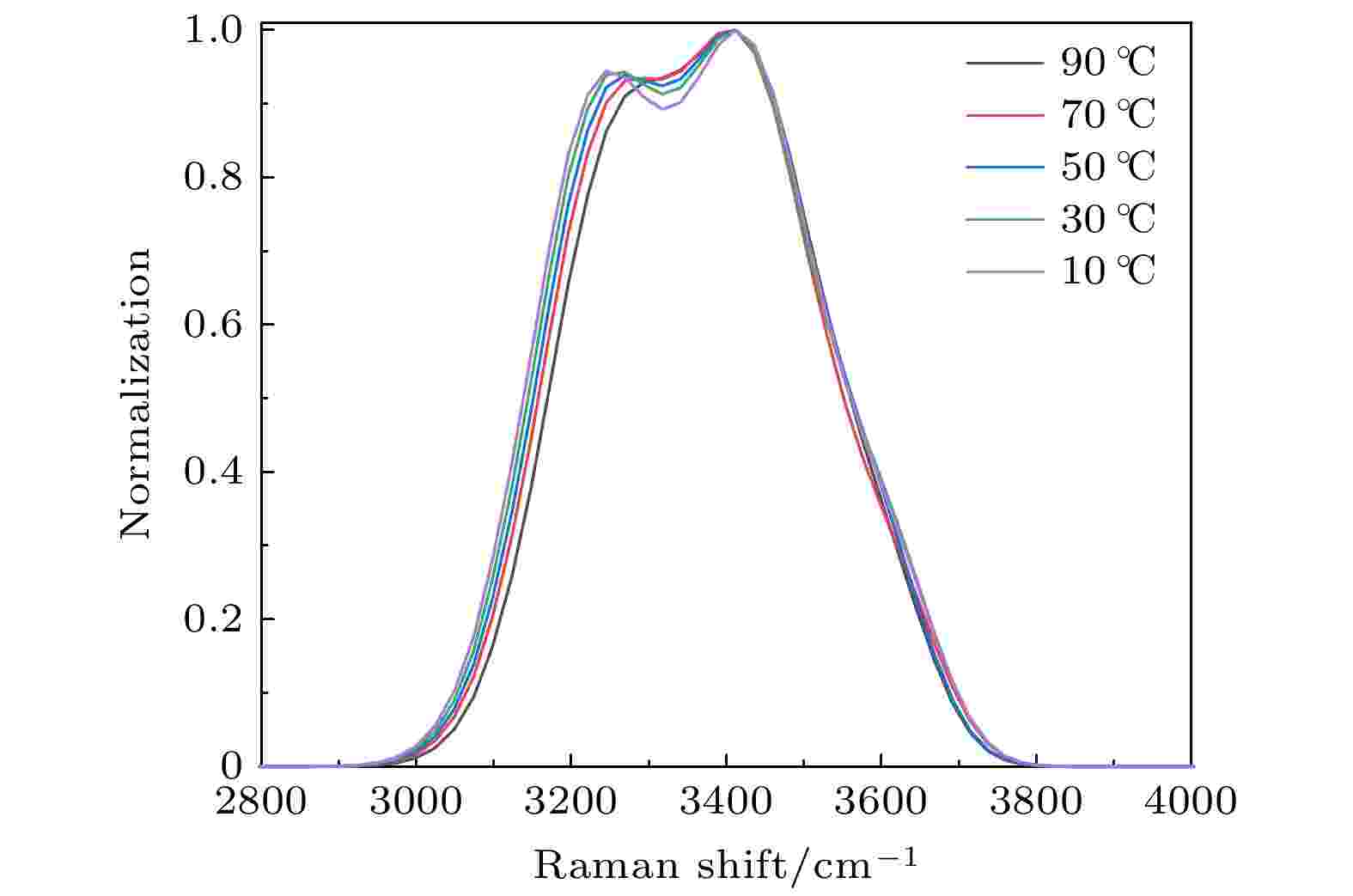 图 2 不同温度下纯水的拉曼散射光谱
图 2 不同温度下纯水的拉曼散射光谱Figure2. Raman scattering spectra of pure water at different temperatures.
水分子有两种存在形式, 一种是独立的单个水分子, 另一种是多个水分子形成的簇团. 单个水分子的Raman散射频率较高, 多个水分子簇团的Raman散射频率较低, 当水温升高时, 水分子的热运动加强, 水中单分子的浓度增多, 多分子簇团的浓度减少, 使得高波数Raman散射光谱强度增大, 低波数Raman散射光谱强度减弱. 依据光谱随温度变化的情况, 可以建立温度与Raman散射光谱之间的关系. 在散射光谱最大峰值位置, 将光谱分为两部分, 低频部分是包含氢键的振动光谱(HB), 高频部分是非氢键的振动光谱(NHB). 分别对HB部分和NHB部分进行积分, 并对积分结果取对数, 可以得到温度和散射光谱低、高频面积比的关系.
由于溶质对水的振动Raman散射光谱影响机制较为复杂, 可通过实验数据定量建立Raman散射光谱与海水盐度的函数关系. 海水是一种化学成分复杂的混合溶液, 主要含有的阴阳离子有Cl1–, SO

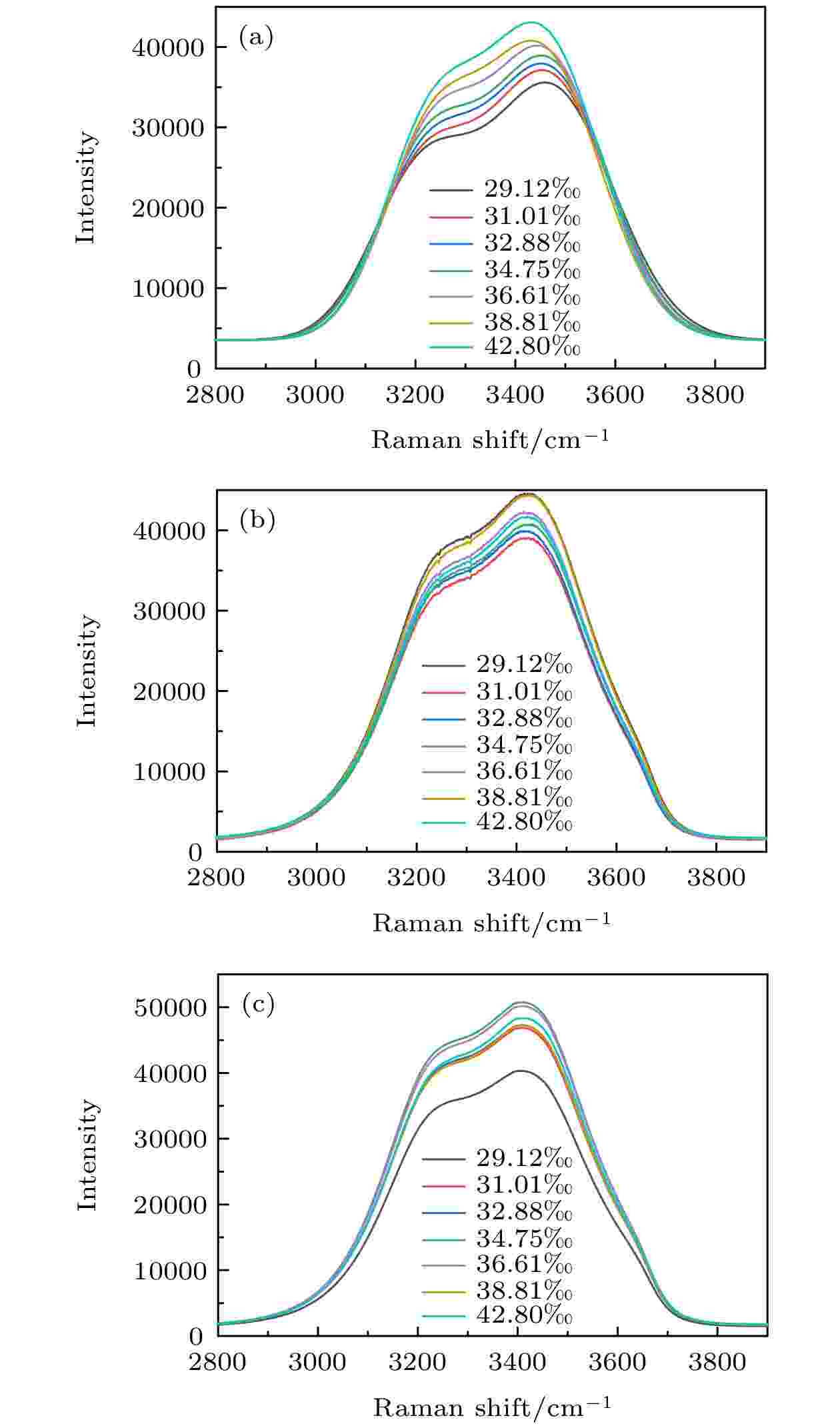 图 3 不同盐度溶液的Raman散射光谱 (a) NaCl溶液; (b) MgCl2溶液; (c) NaCl-MgCl2-Na2SO4三种介质混合溶液
图 3 不同盐度溶液的Raman散射光谱 (a) NaCl溶液; (b) MgCl2溶液; (c) NaCl-MgCl2-Na2SO4三种介质混合溶液Figure3. Raman scattering spectra of different salinity solutions: (a) NaCl solution; (b) MgCl2 solution; (c) NaCl-MgCl2-Na2SO4 three media mixture solutions.
根据单介质溶液和混合介质溶液的Raman散射光谱数据, 利用最小二乘原理, 建立Raman散射光谱与海水温度和盐度之间的函数关系, 如下式:
海水折射率n(S, t, λ)与海水温度和盐度相关, 它们之间的关系如下式[13]:
根据海水所含成分占比, 配制海水样品. 在恒定温度下, 利用实验探测不同盐度下海水的Raman散射光谱, 探测结果如图4所示.
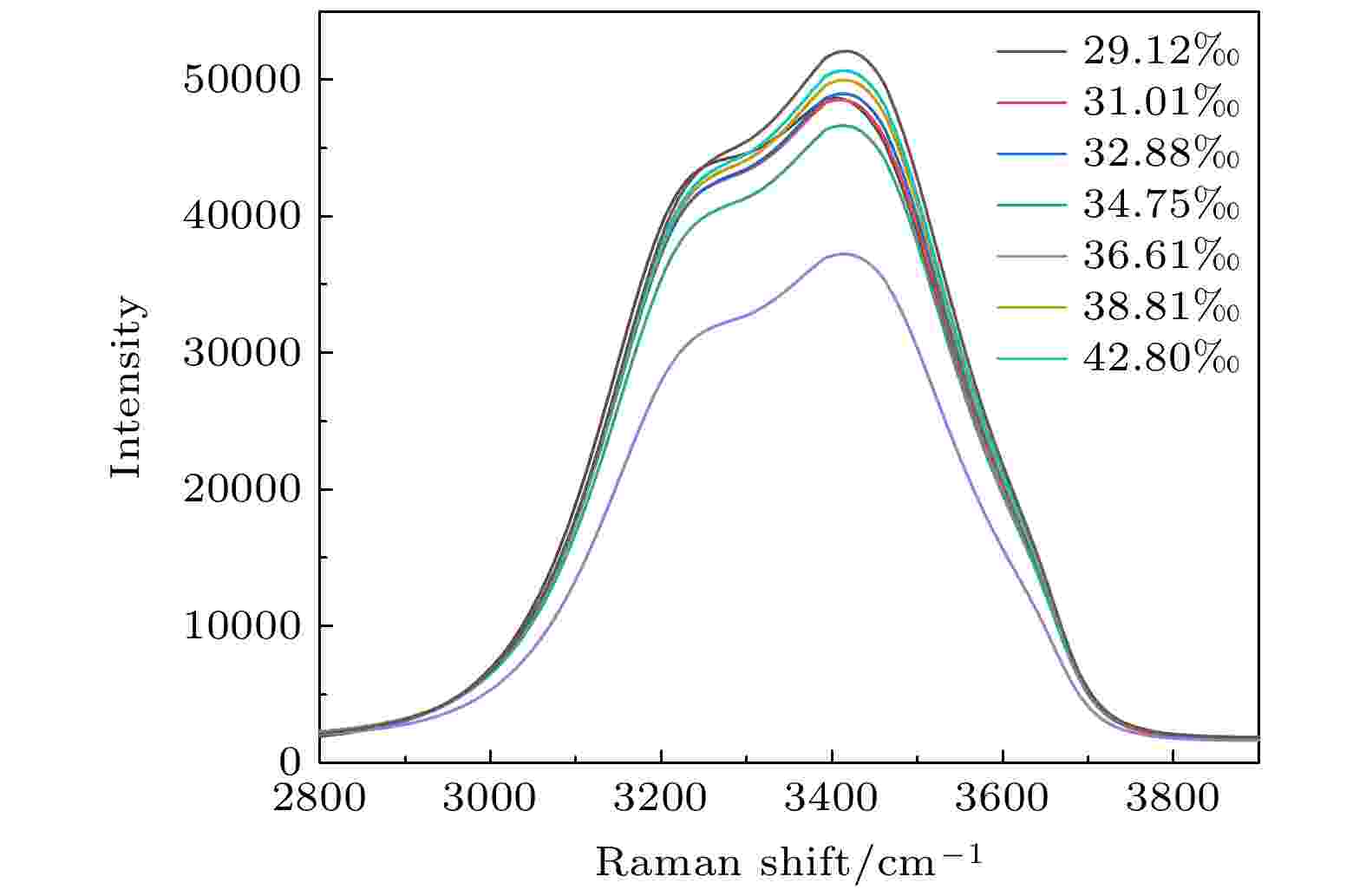 图 4 海水的Raman散射光谱
图 4 海水的Raman散射光谱Figure4. Raman scattering spectrum of seawater.
根据海水Raman散射光谱探测结果, 计算出不同盐度下散射光谱的低、高频面积比的对数值. 由于已知海水温度, 将散射光谱低、高频面积比的对数值结果代入(7)式, 可以反演获得海水盐度. 实验数据计算结果与函数关系计算结果如图5所示, 图中点表示实验探测结果, 直线为函数关系计算结果.
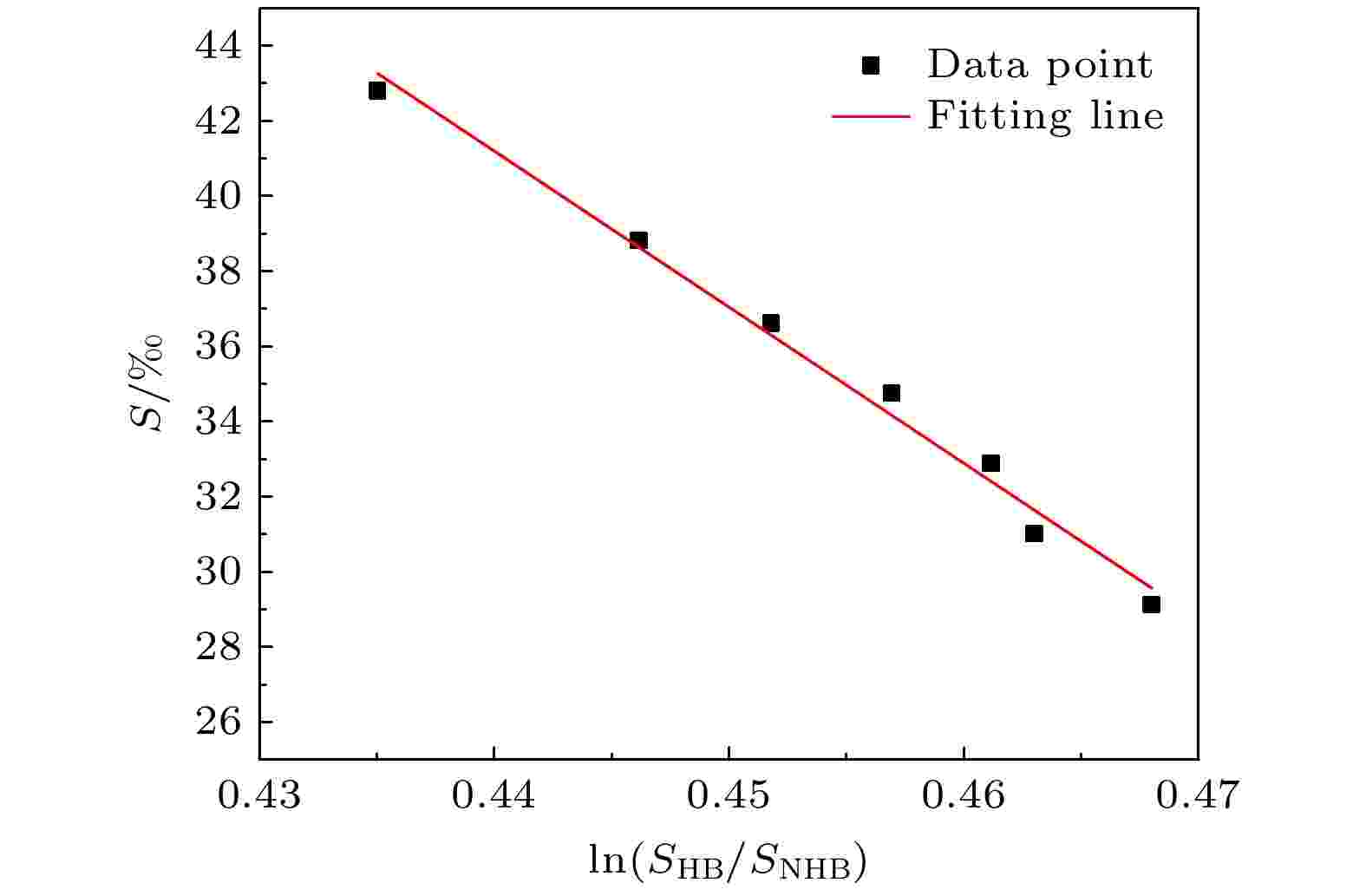 图 5 海水Raman散射光谱数据处理结果
图 5 海水Raman散射光谱数据处理结果Figure5. Data processing results of seawater Raman scattering spectrum.
2
4.2.激光雷达探测Brillouin频移
依据Brillouin散射理论, 图6给出了盐度为35‰时Brillouin的散射光谱. 当温度从20 ℃变为30 ℃, Brillouin频移变化量ΔvB = 0.1142 GHz. 因此在已知海水盐度时, 可以通过激光雷达探测海水Brillouin频移, 利用频移探测结果, 使用(5)式反演获得海水温度.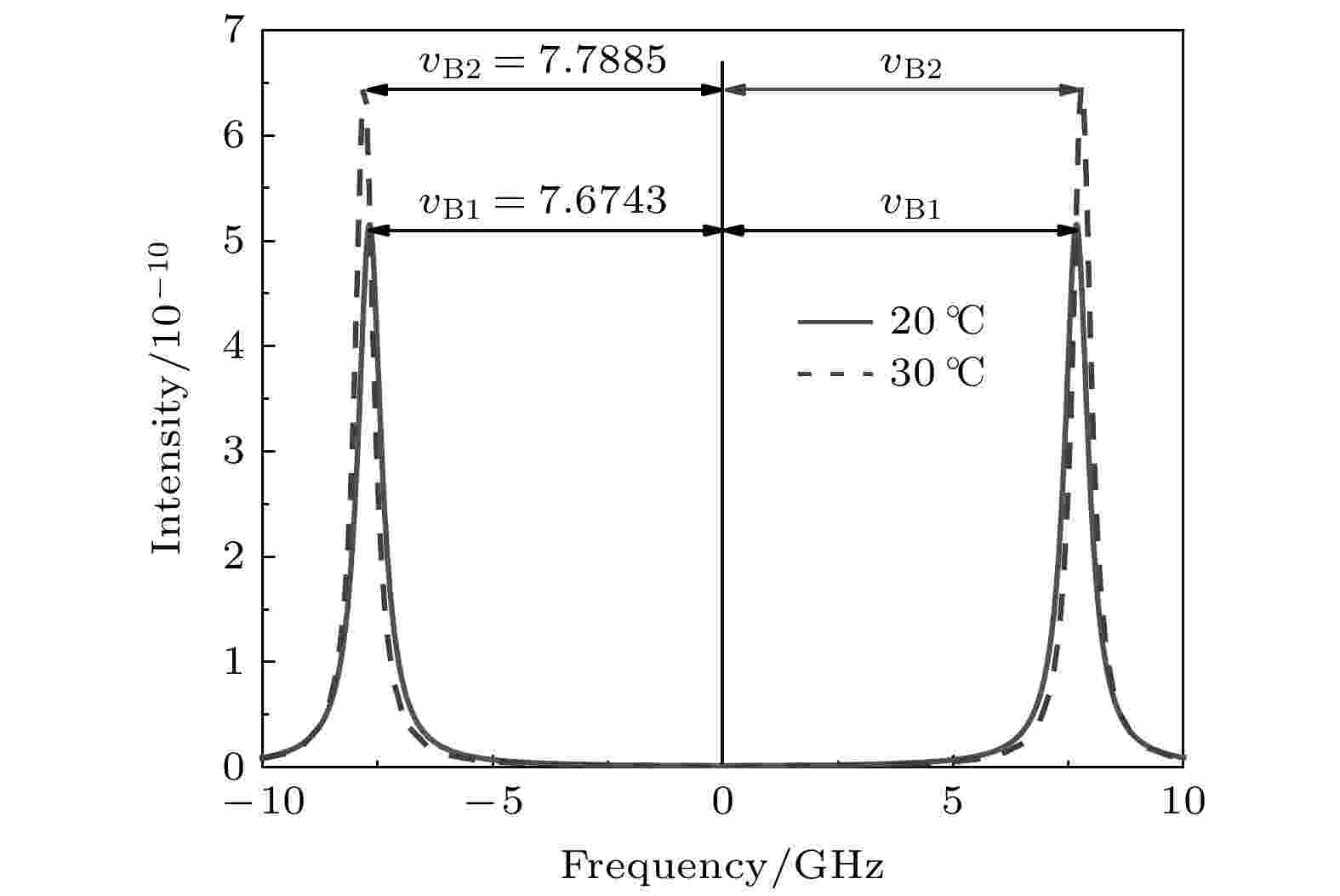 图 6 盐度值为35‰时不同温度下海水Brillouin散射光谱
图 6 盐度值为35‰时不同温度下海水Brillouin散射光谱Figure6. Brillouin scattering spectra of seawater at different temperatures with salinity of 35 ‰.
激光雷达遥感方法探测海水Brillouin频移的方法是, 利用边缘探测技术, 探测得到Brillouin回波信号的能量. 回波信号能量受到Brillouin频移和谱宽两个参量的影响. 其中Brillouin谱宽可以利用光子相关光谱技术探测到, 因此可以利用探测的回波信号能量和Brillouin谱宽计算获得频移. Brillouin频移计算公式如下:
利用(9)式获得恒定盐度下, 不同温度的Brillouin散射谱宽和能量的结果如表1所列.
| t | S | ΓB | I | vB |
| 5 | 30 | 1.2732 | 0.2053 | 7.38705 |
| 10 | 30 | 0.9424 | 0.244 | 7.48328 |
| 15 | 30 | 0.7375 | 0.2859 | 7.56755 |
| 20 | 30 | 0.6130 | 0.3278 | 7.64070 |
| 25 | 30 | 0.5376 | 0.3674 | 7.70355 |
| 30 | 30 | 0.4883 | 0.403 | 7.75694 |
表1恒定盐度下, 不同温度Brillouin线宽、能量和频移计算结果
Table1.Calculation results of Brillouin spectrum width, energy and frequency shift at different temperatures under constant salinity.
2
4.3.海水盐度的联合反演与误差分析
依据(5)式和(7)式, Brillouin频移和Raman散射光谱均是与海水温度及盐度相关的二元函数. 因此联立两个函数关系可以得到海水盐度与Brillouin频移和Raman散射光谱低、高频面积比的对数值ln(SHB/SNHB)之间的函数关系如下式:由于海水Brillouin频移和Raman散射光谱的低、高频面积比的对数值ln(SHB/SNHB)均是用于反演海水盐度的参量, 因此它们的误差会影响海水盐度反演精度. 海水盐度反演的误差计算方法由下式给出:
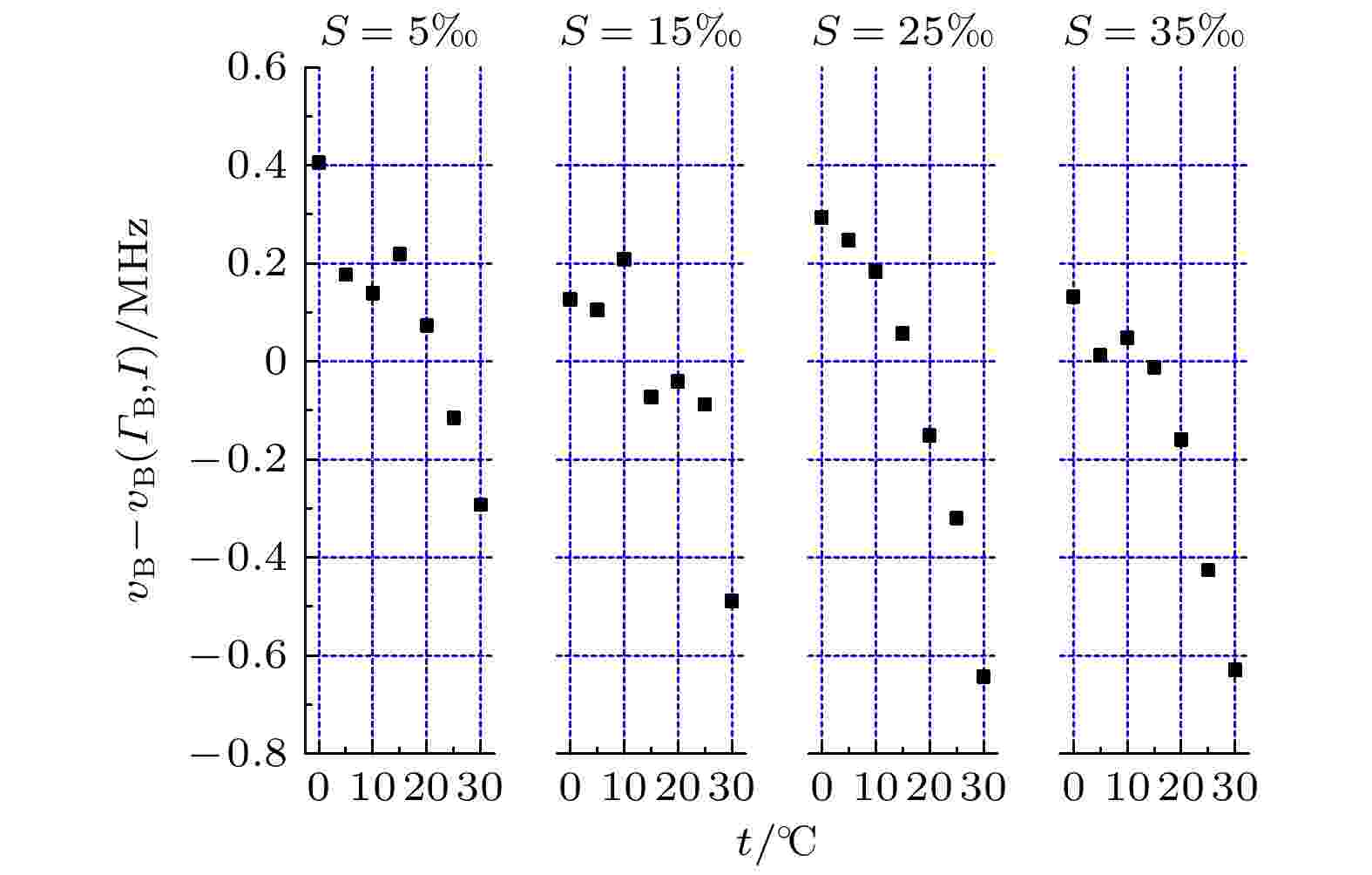 图 7 Brillouin频移拟合关系vB (I, ΓB)与理论计算结果误差
图 7 Brillouin频移拟合关系vB (I, ΓB)与理论计算结果误差Figure7. Difference between fitted Brillouin frequency shift vB (I, ΓB) and theoretical value.
Raman散射光谱低、高频面积比的对数值ln(SHB/SNHB)的误差计算结果如图8所示. 拟合函数关系计算结果与实验结果之间的误差为 ±0.0018. 最终根据Raman散射与Brillouin散射的误差计算结果, 利用(11)式计算海水盐度反演的误差为 ±0.47 ‰.
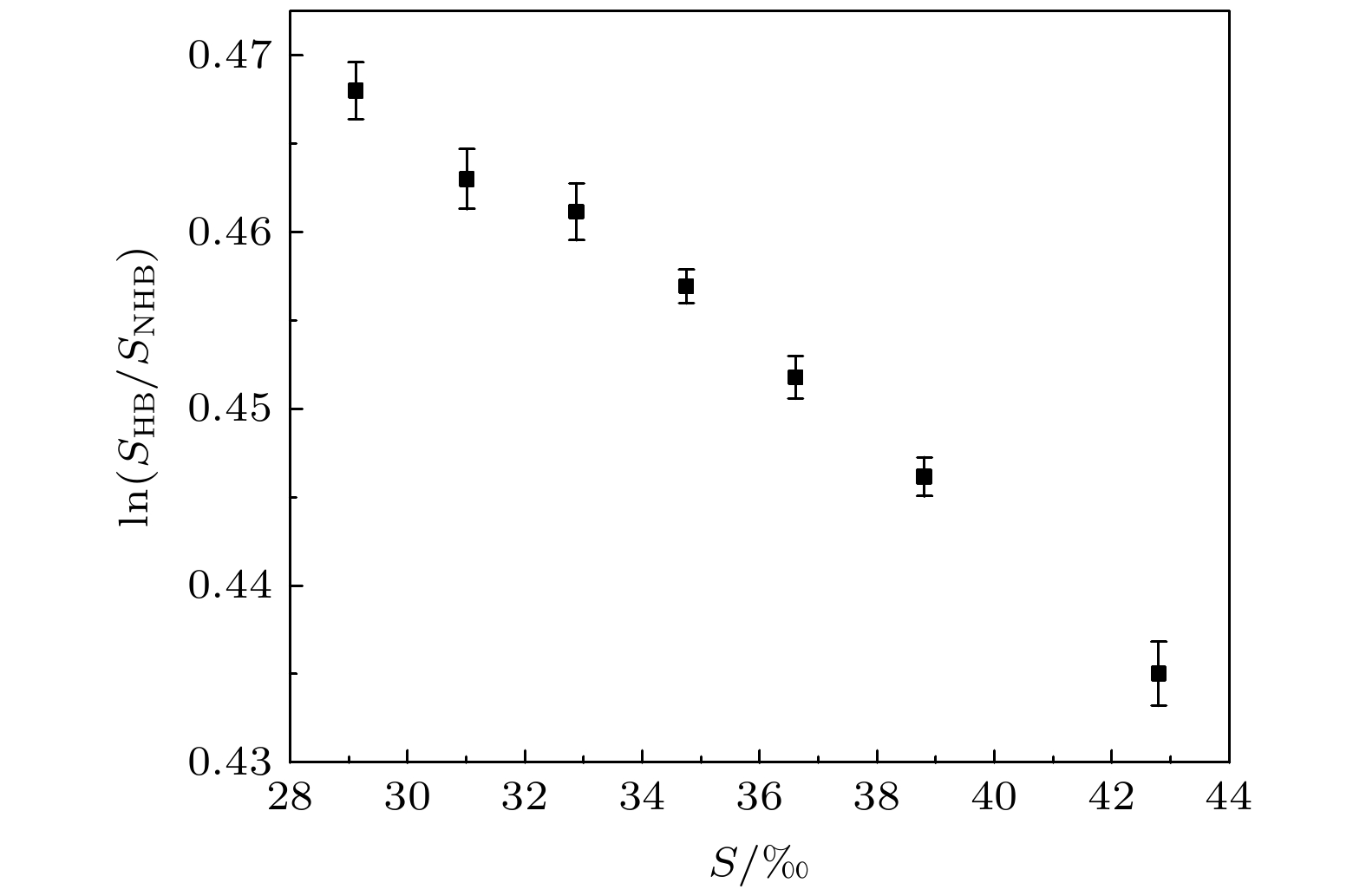 图 8 Raman光谱低、高频面积比的拟合结果与实验结果之间的误差
图 8 Raman光谱低、高频面积比的拟合结果与实验结果之间的误差Figure8. The error between the fitting results of low and high frequency area ratio of Raman spectra and the experimental results.
2
4.4.实验误差分析
海水盐度反演需要探测的参量包括: Raman散射光谱、Brillouin散射谱宽和Brillouin散射回波信号能量. 由于海水温度变化对探测结果有影响, 因此样品海水温度控制精度为 ± 0.2 ℃. 控温误差对Raman散射光谱的低、高频面积比的对数值ln(SHB/SNHB)造成的影响如图9所示, 温度误差对散射光谱低、高频面积比的对数值ln(SHB/SNHB)造成的误差小于0.001.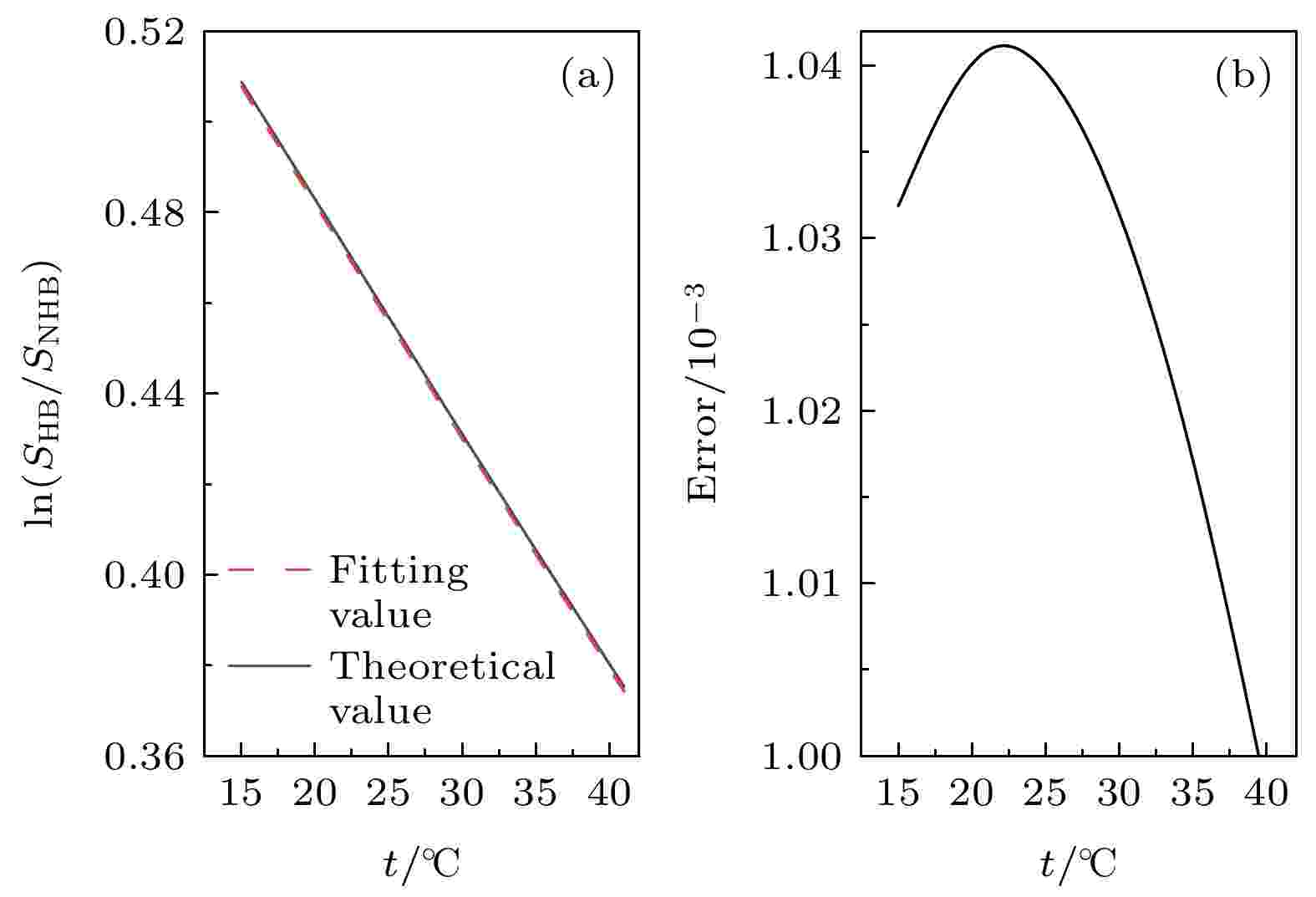 图 9 温度误差对Raman散射光谱低、高频面积比的对数值ln(SHB/SNHB)造成的影响 (a) 恒定盐度, 不同温度下对数面积比理论值与拟合值; (b) 温度误差导致对数面积的误差
图 9 温度误差对Raman散射光谱低、高频面积比的对数值ln(SHB/SNHB)造成的影响 (a) 恒定盐度, 不同温度下对数面积比理论值与拟合值; (b) 温度误差导致对数面积的误差Figure9. Effect of temperature error on the logarithmic value of the low and high frequency area ratio of Raman scattering spectra: (a) theoretical value and fitting value of log area ratio under constant salinity and different temperatures; (b) error of log area caused by temperature error.
实验中温度误差对Brillouin散射探测的影响结果如图10所示, 其中图10(a)和图10(b)表明在温度误差范围内, 对Brillouin谱宽探测结果造成的误差小于5 MHz; 图10(c)和图10(d)表明在温度误差范围内, 对Brillouin散射探测能量造成的误差小于0.0016.
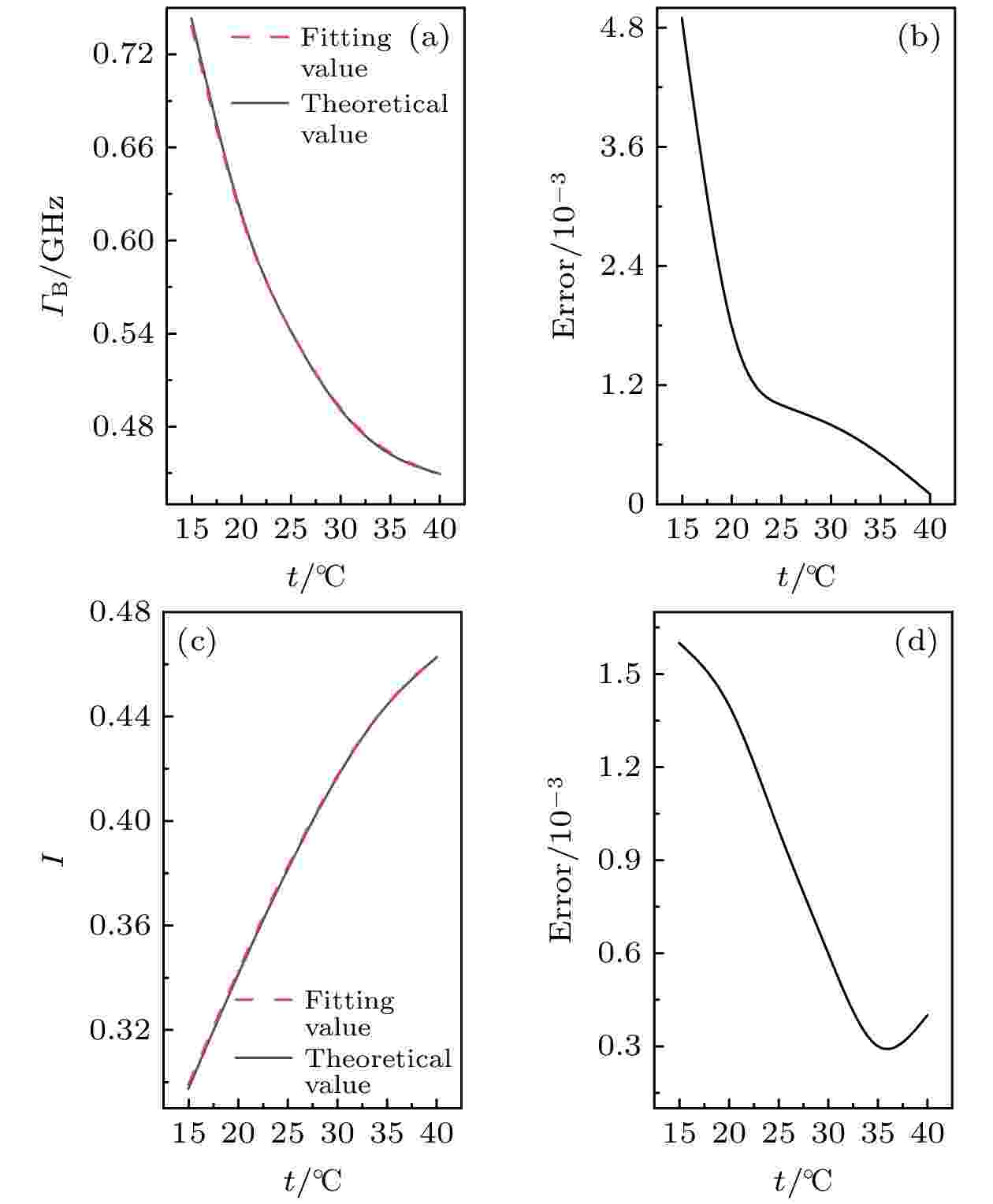 图 10 温度误差对Brillouin散射探测造成的影响 (a) 恒定盐度, 不同温度下谱宽理论值与拟合值; (b) 温度误差导致谱宽探测误差; (c) 恒定盐度, 不同温度下探测能量理论值与拟合值; (d) 温度误差导致能量探测误差
图 10 温度误差对Brillouin散射探测造成的影响 (a) 恒定盐度, 不同温度下谱宽理论值与拟合值; (b) 温度误差导致谱宽探测误差; (c) 恒定盐度, 不同温度下探测能量理论值与拟合值; (d) 温度误差导致能量探测误差Figure10. Effect of temperature error on Brillouin scattering detection: (a) Theoretical and fitting values of spectrum width at different temperatures under constant salinity; (b) temperature error leads to spectrum width detection error; (c) theoretical and fitting values of detection energy at different temperatures under constant salinity; (d) temperature error leads to energy detection error.
温度误差对Raman散射光谱、Brillouin散射谱宽和能量探测造成的影响, 会使得海水盐度反演产生误差. 其中Raman散射光谱探测结果得到的低、高频面积比的对数值ln(SHB/SNHB)的误差, 对盐度反演结果的影响如图11所示, 在低、高频面积比的对数值的误差范围内, 海水盐度反演误差小于0.91‰.
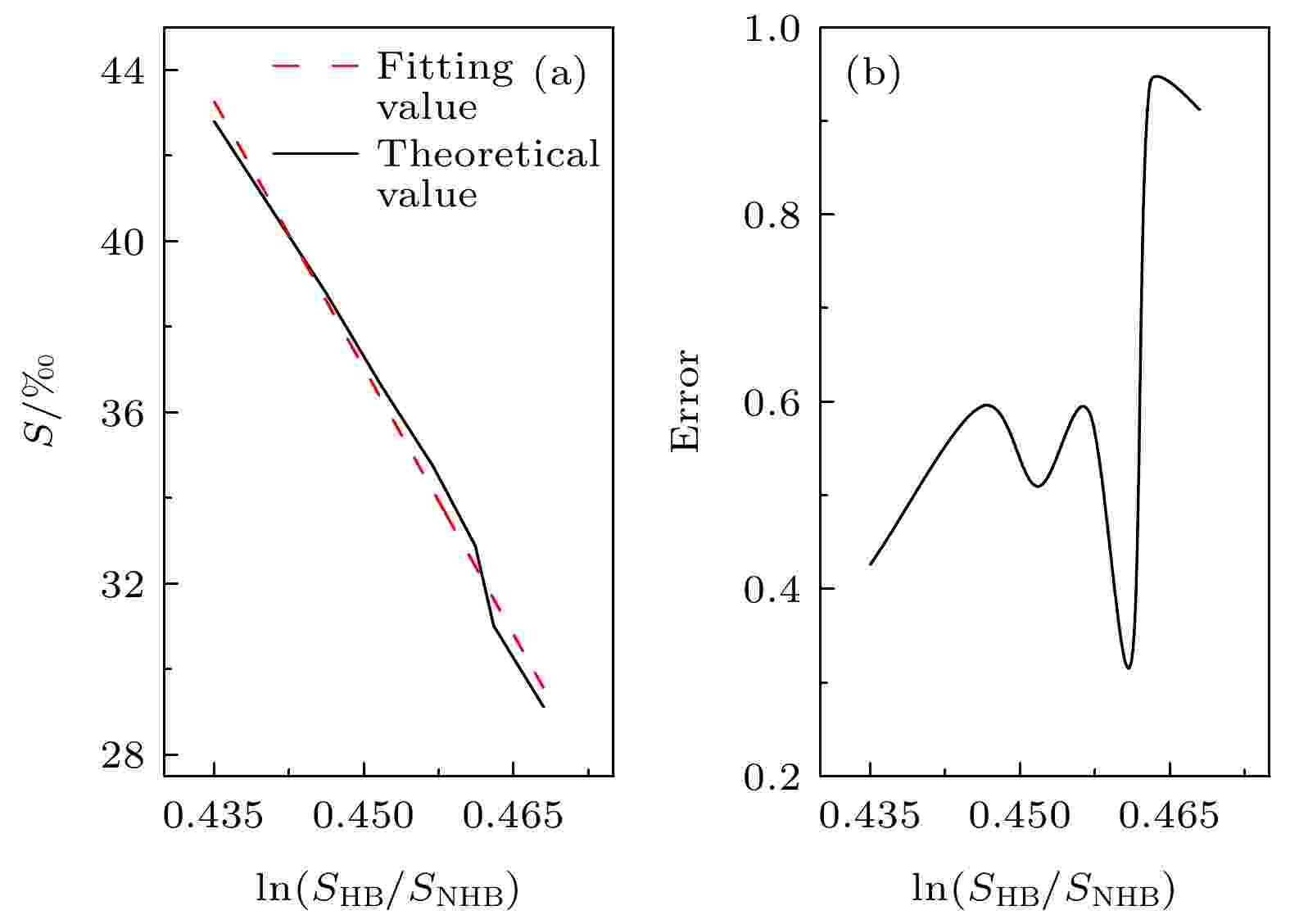 图 11 Raman光谱探测误差对盐度探测结果的影响 (a) 盐度反演结果理论值与拟合值; (b) 盐度反演误差结果
图 11 Raman光谱探测误差对盐度探测结果的影响 (a) 盐度反演结果理论值与拟合值; (b) 盐度反演误差结果Figure11. Effect of Raman spectral detection errors for salinity detection results: (a) theoretical value and fitting value of salinity inversion results; (b) salinity inversion error results.
Brillouin散射探测的误差对海水盐度的反演结果造成的影响如图12所示. 其中图12(a)和图12(b)给出了Brillouin谱宽探测误差对盐度反演的影响, Brillouin谱宽的误差范围内, 海水盐度的反演误差小于0.82 ‰; 图12(c)和图12(d)给出了Brillouin探测能量误差对盐度反演结果的影响, 在探测能量误差范围内, 海水盐度反演误差小于1.34‰.
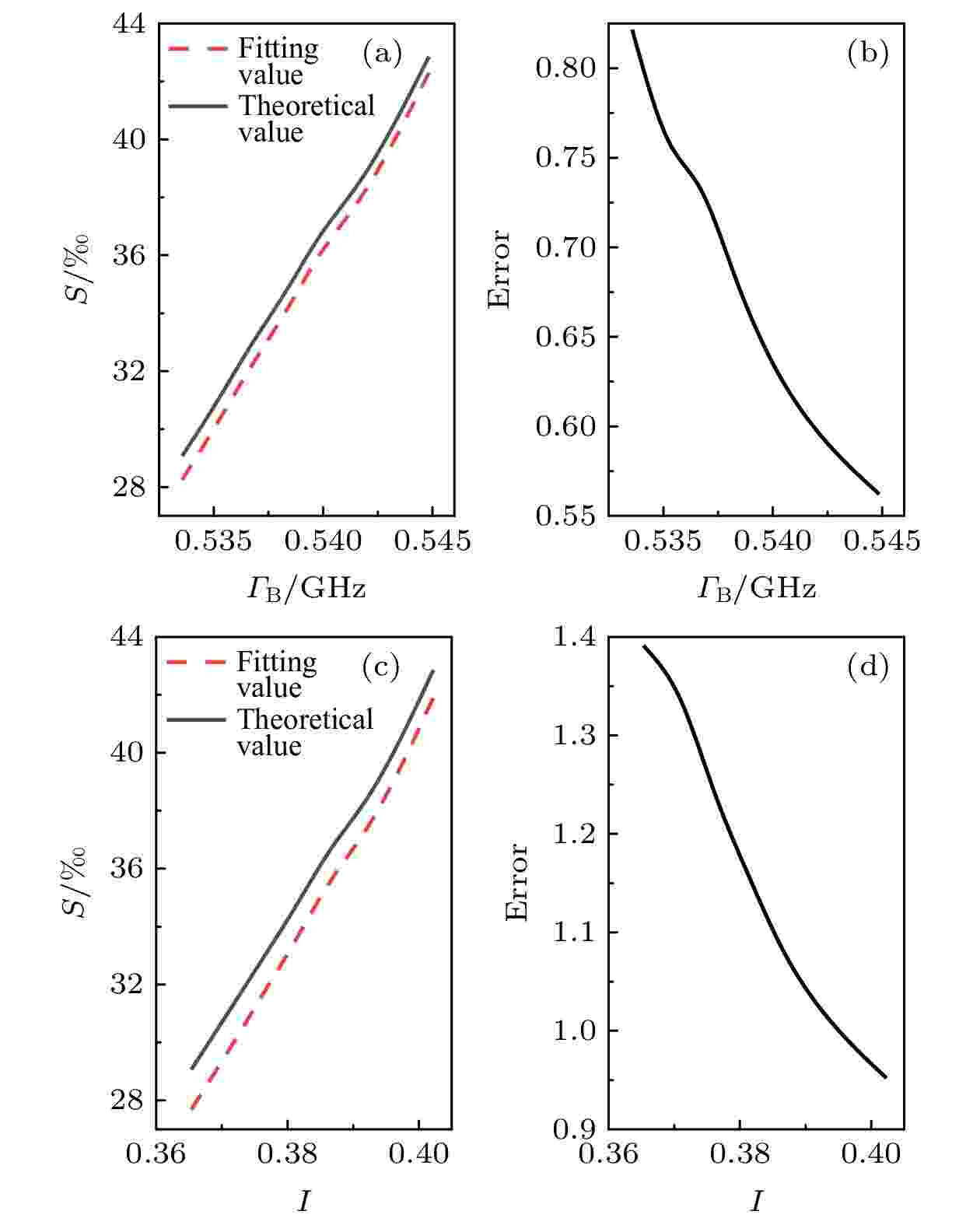 图 12 Brillouin散射探测结果对盐度反演的影响 (a) 谱宽改变时, 盐度反演结果理论值与拟合值; (b) 谱宽误差导致盐度反演结果误差; (c) 能量改变时, 盐度反演结果理论值与拟合值; (d) 能量误差导致盐度反演结果误差
图 12 Brillouin散射探测结果对盐度反演的影响 (a) 谱宽改变时, 盐度反演结果理论值与拟合值; (b) 谱宽误差导致盐度反演结果误差; (c) 能量改变时, 盐度反演结果理论值与拟合值; (d) 能量误差导致盐度反演结果误差Figure12. Influence of Brillouin scattering detection results on salinity inversion: (a) Theoretical value and fitting value of salinity inversion results when the spectral width changes; (b) error of spectral width leads to the error of salinity inversion results; (c) theoretical value and fitting value of salinity inversion results when the energy changes; (d) error of energy leads to the error of salinity inversion results.
